The evolution of racing games, part 2
In the first article about the evolution of racing games, we talked about early examples of car simulators, made in the form of arcade machines and games for consoles. In the 1970s and 1980s, the main set of characteristics of future auto-simulators was formed: a third-person view, realistic control, attention to detail — the drawing of cars and landscapes.
From the very beginning of the history of the genre, we see how the developers tried to make the race process close to real life. Excellent examples are the real Fuji Speedway track in the Pole Position game, controlled skids in the TX-1, the ability to choose a turn in the Out Run, a change in weather conditions in Rad Racer.
If initially it was a revolution in games, then in the late 1980s, car simulators followed the evolutionary path. This was facilitated by the spread of gaming consoles and computers and the expansion of technical capabilities of iron.
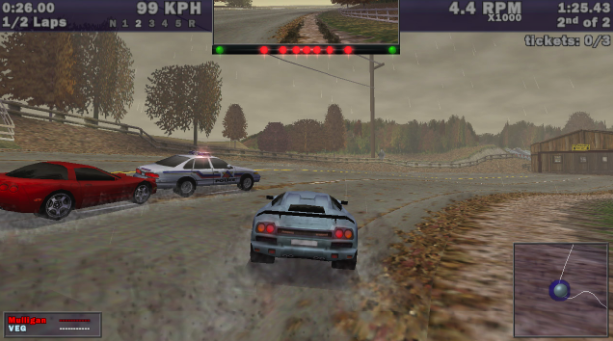
In the comments to the first article, the Grand Prix Circuit game was released, released in 1987 for Amiga, Commodore 64, ZX Spectrum and a number of other platforms. Race in cars involves passing the qualifying round before the race, a single race or participation in the championship. To fit into the turn, you need to slow down. In order not to break the car on the opponent, it is better not to crash into it. Driving on the grass guarantees a reduction in speed. In the game you can choose several different tracks from different countries.
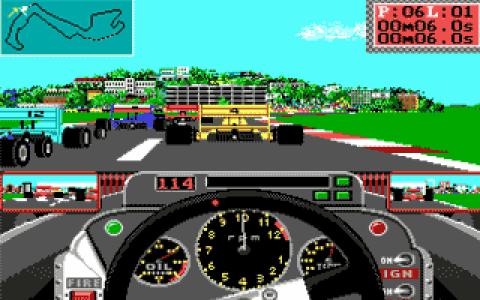
While writing this article, I accidentally stuck in the game for an hour, you can play in the browser at this link . Realism added mirrors and splashes of champagne from the pedestal after the end of the race.
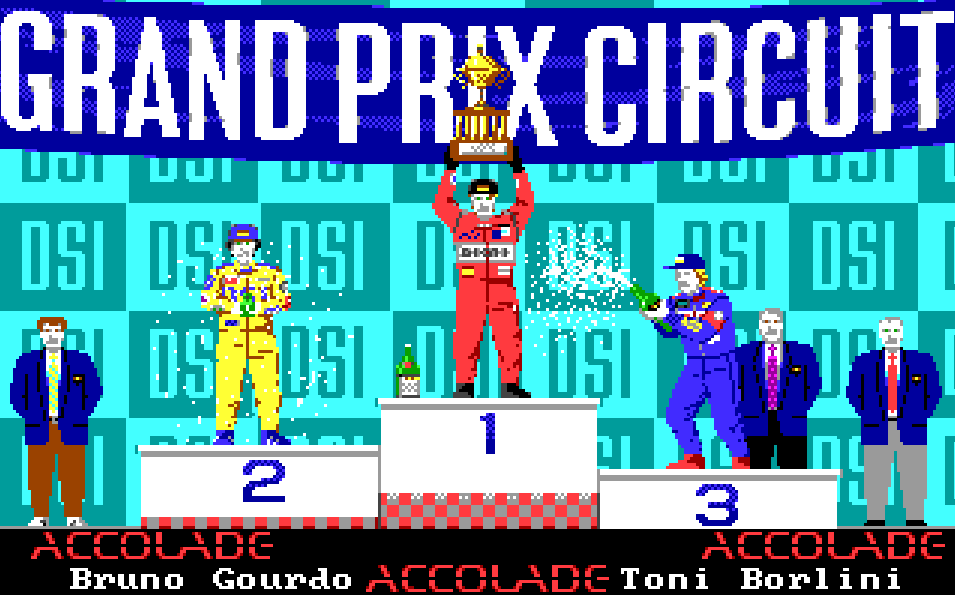
In the game Chase HQ, which was developed first for the machine, and later ported to other platforms, the player drove a Porsche 928 police car and chased the criminals. It was necessary to ram the car of the gangster to inflict sufficient damage. At the same time, it is necessary to bypass other cars and fit into turns.
The versions for Amiga, Commodore 64, Game Boy, NES, ZX Spectrum were released. For individual platforms, the versions differed. For computers there was a digitized speech.
In the continuation of the game Chase HQ II: Special Criminal Investigation, it became possible to shoot at the pursued car - the partner leans out of the car with a gun in his hands. Additional weapons in the form of a grenade launcher can be obtained from a helicopter.
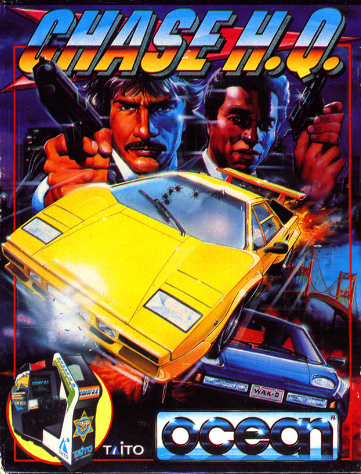
In 1989, Atari released a new car simulator for the gaming machine - Hard Drivin '. The fact that the game had a tactile response is not surprising - in machines this technique has been used for many years. And it is not so interesting that on the track it was necessary to perform tricks. The most important - Hard Drivin 'became the first racing game with 3D-polygonal graphics. Before that, scaled two-dimensional sprites were used in games.
Of the other interesting innovations - the replay of the moment of the accident before continuing the game.
To ensure the realism of driving, the developers collaborated with Doug Milliken, whose father was involved in adapting the mathematics of aircraft movement to formulas for a car in the 1950s.
The game was ported to various platforms, including the Sega Mega Drive.
Kill some of the work day here .
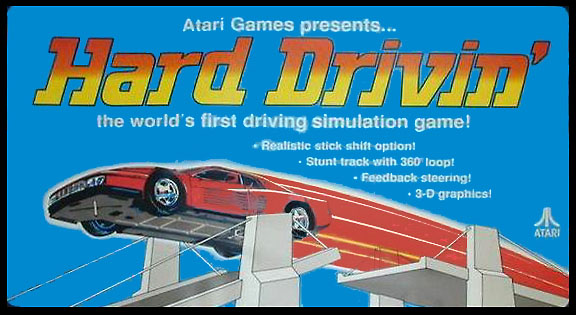
Manufacturers of games continued to work on the realistic behavior of the car on the road. In 1989, the game Indianapolis 500: The Simulation introduced the setting of parameters of the car: suspension, telemetry, weight distribution between the wheels.
But this is not the most important thing. It is interesting that the game repeated the real races. See how interesting it is to spend two and a half hours in one race. Two hundred laps is not two. You can try it yourself .
The game implemented an interesting damage model. If the right front tire - in the flaps, it becomes much more difficult to go.
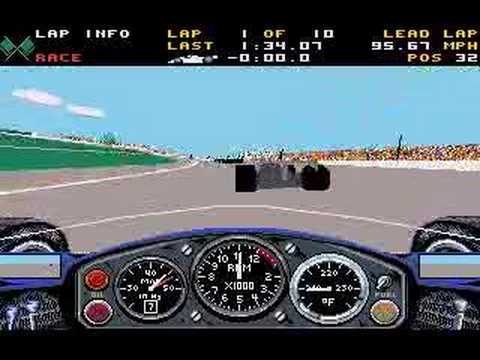
One arrival is clearly not enough. Because Formula One Grand Prix 1992 could boast a whole racing season on real tracks. The developers gave the user the opportunity to choose tires, adjust the angle of rear wings. The driver assistance function was added to the game: an optimal trajectory was drawn on the track.
The game has become one of the first in the genre of games with a strong online community. It was possible to fight with one rival over the network, but there was one drawback: the constant frame rate slowed down the computer at high graphics settings, with which the hardware could not cope. And such a problem in one player braked the entire network game.
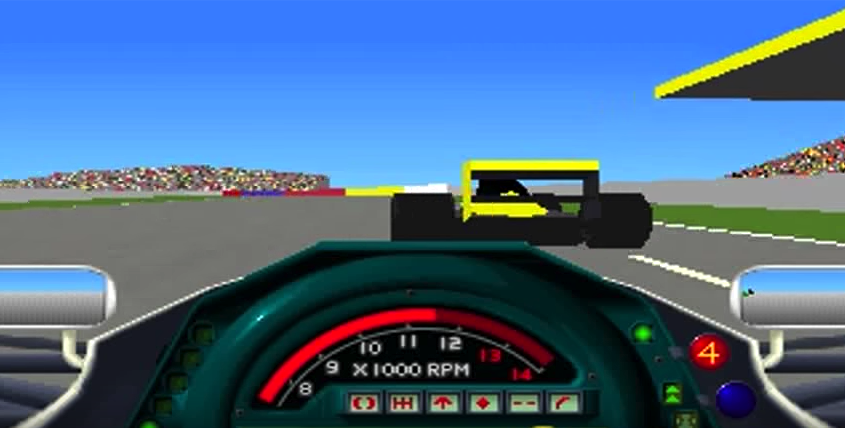
Until 2002, there were three more games in the series. Grand Prix 2, released in 1996, modeled the 1994 Formula One season. The game was at that time one of the best examples of artificial intelligence and physics in car simulators. And the graphics were much better than its predecessor. Cars are more like real ones. At the pit stop, the player decided how many laps to fill the car and which tires to use.
Interestingly, the advertising in the game was real. You can see the posters SEIKO, Mobil1, Ford, Alfa Romeo, Campari and other brands.
In 1992, Sega broke into the autosimulator race with a new arcade game, later ported to other platforms from Sega. It was Virtua Racing, the first 3D racing game from this manufacturer.
In order for the console to cope with the graphics, the cartridge included an additional Sega Virtua Processor processor. The processor allowed the console to process polygons in real time, scale and rotate objects.
Virtua Racing carts with this processor have become the most expensive games for Genesis - they cost about $ 100.

Cartridge with processor - inside view. Source
But what are we all about cars! There are races on other vehicles, such as motorcycles, fire engines and karts. It was karting in 1992 that took over the most popular game character - Mario. In the Super Mario Kart game on the Super Ninendo Entertainment System, the player chose from eight game characters. For each character, speed and control were different.
An important goal for the creators of Super Mario Kart was the realization of the game for two characters on one screen. In the game for two, the screen was divided horizontally, so that each player could see his character from behind from above. In a single player game, the bottom of the screen was occupied by a track map.
The game has become one of the best selling for SNES.

In 1993, the Namco Ridge Racer slot machine even had a grid-girl, a girl in a swimsuit at the start. The game was later ported to the Sony PlayStation.
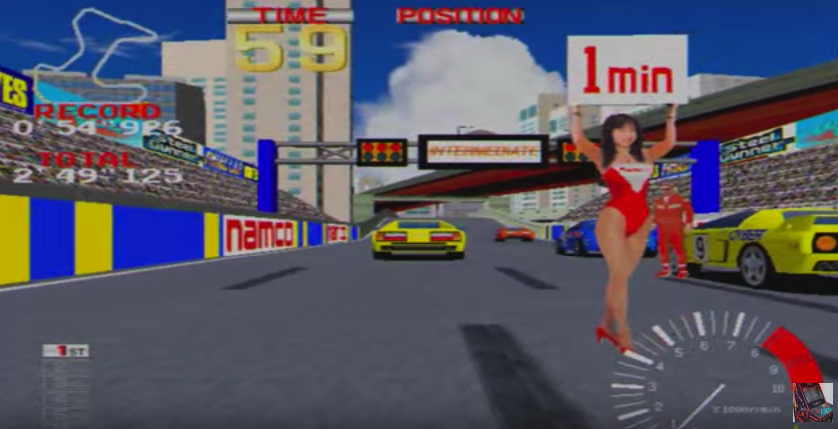
The answer from Sega was Daytona USA with the most advanced graphics for 1993. The player drove the Hornet car - its prototype was a Chevrolet Lumina NASCAR. The game had a choice between automatic and manual transmission. Manual transmission allows you to develop a higher speed with proper gear shifting. Damage to the car slows down, but you can repair the car right on the highway.
The artificial intelligence in the game analyzed the player's skills on the first lap in order to further change the speed of the opponents.

In 1994, the story began of the most famous and popular series of racing games - Need For Speed. The first game was released on a disk for the 5th generation 3DO console , which was produced by Panasonic, Sanyo, Creative and Goldstar for just three years. Then the game was released for other platforms, including the first Sony PlayStation. In the screensaver used real video.
In the game it was possible to choose a car and a highway, a view from the cabin or from a third person. The most important was that the game was an attempt to achieve compliance with the actual behavior of the car. To solve this problem, Electronic Arts has worked with the road magazine Road & Track. Even the sound of the gear lever control coincides with the real one. In the game you can watch the interior and exterior of cars, videos on the topic of cars - like in a magazine or a thematic TV show.

Already in the 1987 Grand Prix Circuit, the speed of the car was reduced when the player was driving off the road - on the grass. In the 1995 Sega Rally Championship, it was decided to add a few different surfaces with different friction properties to add realism: asphalt, gravel, dirt. The behavior of the car changed depending on the conditions.
The player chooses between two cars - Toyota Celica and Lancia Delta, then adjusts the steering sensitivity, suspension stiffness, tire friction coefficient.

An interesting feature of the TX-1 game, released by Tatsumi in 1983, was a fork. The player could choose a turn. This theme was continued to develop in Out Run, and in Konami's 1996 GTI Club, it was brought to almost free movement around the city. And here it was possible to cut the road, destroy the cafe, that is, do what we love the race for. In addition to speed.
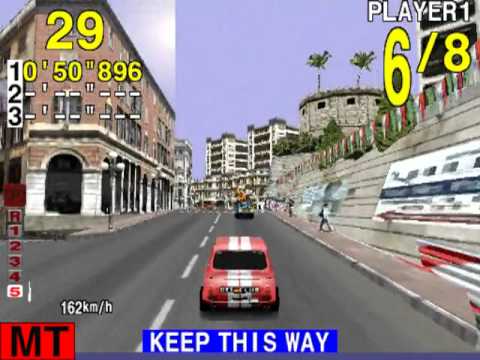
In 1997, Atari was the first to use 3D polygonal graphics in a racing game. It was San Frincisco Ruch. The game was available in slot machines and consoles Nintendo 64, Sony PlayStation, Game Boy Color and PC. No innovation in the game can be traced, this time Atari was in the role of catching up.

Need for Speed III: Hot Pursuit seemed to be the highest degree of visual realism in 1998. Watching the video from the gameplay, you know, in fact, the games today have advanced in terms of graphics. Nevertheless, if today you sit down at the PS1 and start playing, it is unlikely that you will quickly break away from the console.
The most interesting mode in the game was not racing against rivals in cars, but attempts to avoid arrest or racing as policemen. It was especially nice to play together on one set-top box - one person for the police, the second for a cab. Police can cause barriers and spikes on the road.
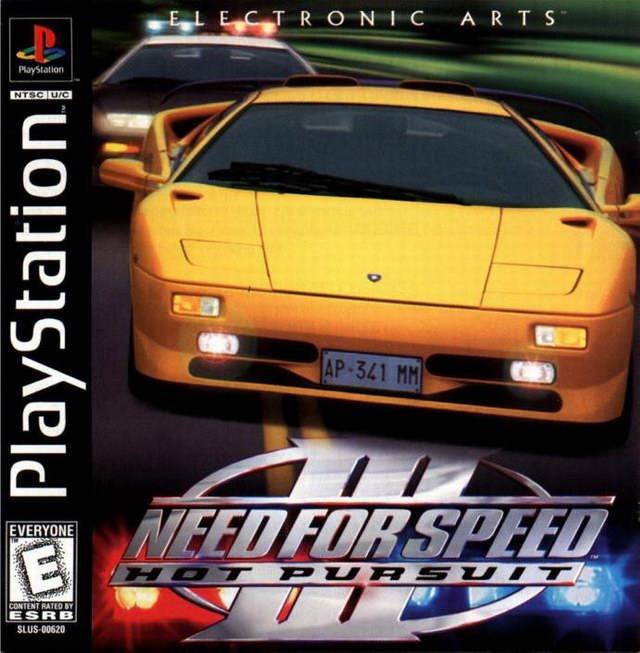
Gran Turismo for Sony PlayStation has become a new stage in realistic racing. The game was released in 1997 after five years of development. Here were the possibilities of tuning cars, career mode with driving exams, the choice of races.
Personally, I remember how hard it was to play Gran Turismo after Need for Speed III: Hot Pursuit 1998, in which realism suffered in order to simplify the process of the game. In Gran Turismo cars led, drifted, it was necessary to try hard to fit into the turns and not crash into each wall. The GT line has become one of the most popular racing franchises in the world.
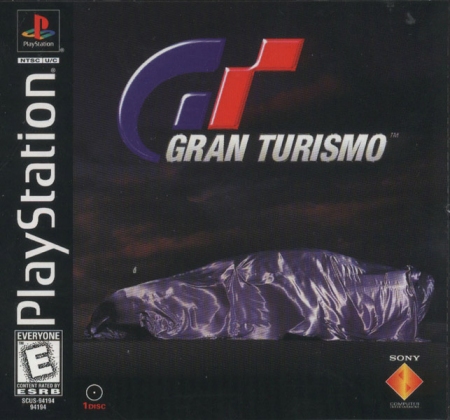
In 1997-1998 my acquaintance with racing games began. Before that, I had Dendy, but in those years my brother had a Sony PlayStation. We flirted with Tekken II and III, and in the second part, sometimes on arcade machines, we played Crash Bandicot and Enter the Gecko. Of the racing games we had three main ones: the already mentioned Need For Speed and Gran Turismo, and also the Colin McRae Rally.
Developers from Codemasters helped real pilot - Colin McRae. The game of 1998 could boast of high realism: a wide choice of a car - more than ten, a large number of tracks and real names of riders. The first game in the series repeated the 1998 World Rally Championship.
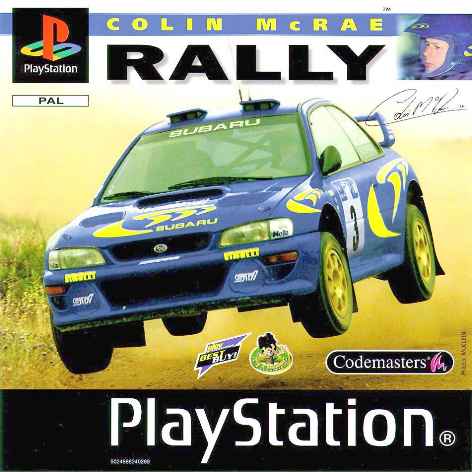
Need for Speed: High Stakes, released in 1999, had race modes with a prize in the form of a loser’s car — High Stakes, chases — Hot Pursuit, and careers. The player earned money, bought new cars, repaired the body of old ones, modernized the car, improving its characteristics.
This time, the management added realism. Graphics significantly improved compared with the third game of the series. And now a helicopter has appeared in the game! Unfortunately, only in Test Drive mode. And only after entering the code Whirly as a player name.
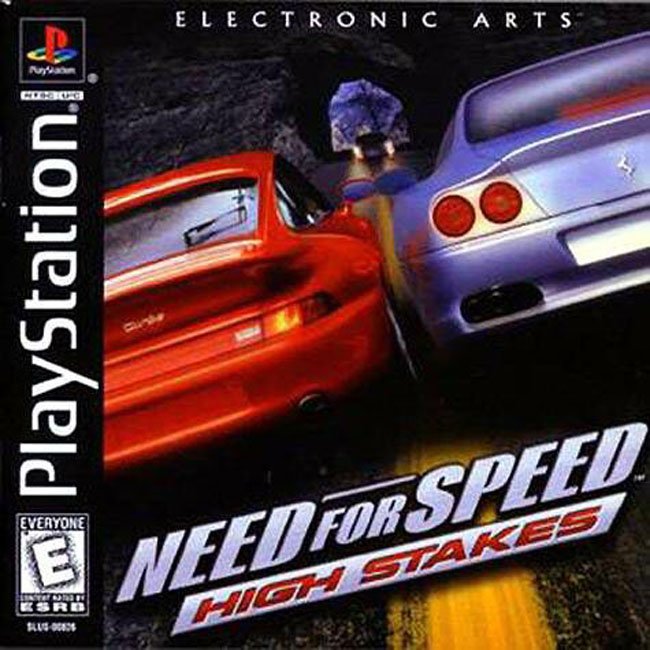
In the late 1980s and in the 1990s, the capabilities of computers and set-top boxes increased significantly. But even on 16-bit consoles, developers could use 3D graphics - this was facilitated by a separate processor right in the cartridge. The availability of platforms provided game manufacturers with sales.
The main event of this period in the history of racing games was the transition from two-dimensional sprite graphics from pseudo-3D to real 3D-polygonal graphics. Developers improved the visual range, continuing to improve the realism of the world.
The next step will be even greater freedom of movement on the tracks and cities. On the evolution of racing games after the year 2000, we will talk in the next article.

From the very beginning of the history of the genre, we see how the developers tried to make the race process close to real life. Excellent examples are the real Fuji Speedway track in the Pole Position game, controlled skids in the TX-1, the ability to choose a turn in the Out Run, a change in weather conditions in Rad Racer.
If initially it was a revolution in games, then in the late 1980s, car simulators followed the evolutionary path. This was facilitated by the spread of gaming consoles and computers and the expansion of technical capabilities of iron.

In the comments to the first article, the Grand Prix Circuit game was released, released in 1987 for Amiga, Commodore 64, ZX Spectrum and a number of other platforms. Race in cars involves passing the qualifying round before the race, a single race or participation in the championship. To fit into the turn, you need to slow down. In order not to break the car on the opponent, it is better not to crash into it. Driving on the grass guarantees a reduction in speed. In the game you can choose several different tracks from different countries.

While writing this article, I accidentally stuck in the game for an hour, you can play in the browser at this link . Realism added mirrors and splashes of champagne from the pedestal after the end of the race.

In the game Chase HQ, which was developed first for the machine, and later ported to other platforms, the player drove a Porsche 928 police car and chased the criminals. It was necessary to ram the car of the gangster to inflict sufficient damage. At the same time, it is necessary to bypass other cars and fit into turns.
The versions for Amiga, Commodore 64, Game Boy, NES, ZX Spectrum were released. For individual platforms, the versions differed. For computers there was a digitized speech.
In the continuation of the game Chase HQ II: Special Criminal Investigation, it became possible to shoot at the pursued car - the partner leans out of the car with a gun in his hands. Additional weapons in the form of a grenade launcher can be obtained from a helicopter.

In 1989, Atari released a new car simulator for the gaming machine - Hard Drivin '. The fact that the game had a tactile response is not surprising - in machines this technique has been used for many years. And it is not so interesting that on the track it was necessary to perform tricks. The most important - Hard Drivin 'became the first racing game with 3D-polygonal graphics. Before that, scaled two-dimensional sprites were used in games.
Of the other interesting innovations - the replay of the moment of the accident before continuing the game.
To ensure the realism of driving, the developers collaborated with Doug Milliken, whose father was involved in adapting the mathematics of aircraft movement to formulas for a car in the 1950s.
The game was ported to various platforms, including the Sega Mega Drive.
Kill some of the work day here .

Manufacturers of games continued to work on the realistic behavior of the car on the road. In 1989, the game Indianapolis 500: The Simulation introduced the setting of parameters of the car: suspension, telemetry, weight distribution between the wheels.
But this is not the most important thing. It is interesting that the game repeated the real races. See how interesting it is to spend two and a half hours in one race. Two hundred laps is not two. You can try it yourself .
The game implemented an interesting damage model. If the right front tire - in the flaps, it becomes much more difficult to go.

One arrival is clearly not enough. Because Formula One Grand Prix 1992 could boast a whole racing season on real tracks. The developers gave the user the opportunity to choose tires, adjust the angle of rear wings. The driver assistance function was added to the game: an optimal trajectory was drawn on the track.
The game has become one of the first in the genre of games with a strong online community. It was possible to fight with one rival over the network, but there was one drawback: the constant frame rate slowed down the computer at high graphics settings, with which the hardware could not cope. And such a problem in one player braked the entire network game.

Until 2002, there were three more games in the series. Grand Prix 2, released in 1996, modeled the 1994 Formula One season. The game was at that time one of the best examples of artificial intelligence and physics in car simulators. And the graphics were much better than its predecessor. Cars are more like real ones. At the pit stop, the player decided how many laps to fill the car and which tires to use.
Interestingly, the advertising in the game was real. You can see the posters SEIKO, Mobil1, Ford, Alfa Romeo, Campari and other brands.
In 1992, Sega broke into the autosimulator race with a new arcade game, later ported to other platforms from Sega. It was Virtua Racing, the first 3D racing game from this manufacturer.
In order for the console to cope with the graphics, the cartridge included an additional Sega Virtua Processor processor. The processor allowed the console to process polygons in real time, scale and rotate objects.
Virtua Racing carts with this processor have become the most expensive games for Genesis - they cost about $ 100.

Cartridge with processor - inside view. Source
But what are we all about cars! There are races on other vehicles, such as motorcycles, fire engines and karts. It was karting in 1992 that took over the most popular game character - Mario. In the Super Mario Kart game on the Super Ninendo Entertainment System, the player chose from eight game characters. For each character, speed and control were different.
An important goal for the creators of Super Mario Kart was the realization of the game for two characters on one screen. In the game for two, the screen was divided horizontally, so that each player could see his character from behind from above. In a single player game, the bottom of the screen was occupied by a track map.
The game has become one of the best selling for SNES.

In 1993, the Namco Ridge Racer slot machine even had a grid-girl, a girl in a swimsuit at the start. The game was later ported to the Sony PlayStation.

The answer from Sega was Daytona USA with the most advanced graphics for 1993. The player drove the Hornet car - its prototype was a Chevrolet Lumina NASCAR. The game had a choice between automatic and manual transmission. Manual transmission allows you to develop a higher speed with proper gear shifting. Damage to the car slows down, but you can repair the car right on the highway.
The artificial intelligence in the game analyzed the player's skills on the first lap in order to further change the speed of the opponents.

In 1994, the story began of the most famous and popular series of racing games - Need For Speed. The first game was released on a disk for the 5th generation 3DO console , which was produced by Panasonic, Sanyo, Creative and Goldstar for just three years. Then the game was released for other platforms, including the first Sony PlayStation. In the screensaver used real video.
In the game it was possible to choose a car and a highway, a view from the cabin or from a third person. The most important was that the game was an attempt to achieve compliance with the actual behavior of the car. To solve this problem, Electronic Arts has worked with the road magazine Road & Track. Even the sound of the gear lever control coincides with the real one. In the game you can watch the interior and exterior of cars, videos on the topic of cars - like in a magazine or a thematic TV show.

Already in the 1987 Grand Prix Circuit, the speed of the car was reduced when the player was driving off the road - on the grass. In the 1995 Sega Rally Championship, it was decided to add a few different surfaces with different friction properties to add realism: asphalt, gravel, dirt. The behavior of the car changed depending on the conditions.
The player chooses between two cars - Toyota Celica and Lancia Delta, then adjusts the steering sensitivity, suspension stiffness, tire friction coefficient.

An interesting feature of the TX-1 game, released by Tatsumi in 1983, was a fork. The player could choose a turn. This theme was continued to develop in Out Run, and in Konami's 1996 GTI Club, it was brought to almost free movement around the city. And here it was possible to cut the road, destroy the cafe, that is, do what we love the race for. In addition to speed.

In 1997, Atari was the first to use 3D polygonal graphics in a racing game. It was San Frincisco Ruch. The game was available in slot machines and consoles Nintendo 64, Sony PlayStation, Game Boy Color and PC. No innovation in the game can be traced, this time Atari was in the role of catching up.

Need for Speed III: Hot Pursuit seemed to be the highest degree of visual realism in 1998. Watching the video from the gameplay, you know, in fact, the games today have advanced in terms of graphics. Nevertheless, if today you sit down at the PS1 and start playing, it is unlikely that you will quickly break away from the console.
The most interesting mode in the game was not racing against rivals in cars, but attempts to avoid arrest or racing as policemen. It was especially nice to play together on one set-top box - one person for the police, the second for a cab. Police can cause barriers and spikes on the road.

Gran Turismo for Sony PlayStation has become a new stage in realistic racing. The game was released in 1997 after five years of development. Here were the possibilities of tuning cars, career mode with driving exams, the choice of races.
Personally, I remember how hard it was to play Gran Turismo after Need for Speed III: Hot Pursuit 1998, in which realism suffered in order to simplify the process of the game. In Gran Turismo cars led, drifted, it was necessary to try hard to fit into the turns and not crash into each wall. The GT line has become one of the most popular racing franchises in the world.

In 1997-1998 my acquaintance with racing games began. Before that, I had Dendy, but in those years my brother had a Sony PlayStation. We flirted with Tekken II and III, and in the second part, sometimes on arcade machines, we played Crash Bandicot and Enter the Gecko. Of the racing games we had three main ones: the already mentioned Need For Speed and Gran Turismo, and also the Colin McRae Rally.
Developers from Codemasters helped real pilot - Colin McRae. The game of 1998 could boast of high realism: a wide choice of a car - more than ten, a large number of tracks and real names of riders. The first game in the series repeated the 1998 World Rally Championship.

Need for Speed: High Stakes, released in 1999, had race modes with a prize in the form of a loser’s car — High Stakes, chases — Hot Pursuit, and careers. The player earned money, bought new cars, repaired the body of old ones, modernized the car, improving its characteristics.
This time, the management added realism. Graphics significantly improved compared with the third game of the series. And now a helicopter has appeared in the game! Unfortunately, only in Test Drive mode. And only after entering the code Whirly as a player name.

In the late 1980s and in the 1990s, the capabilities of computers and set-top boxes increased significantly. But even on 16-bit consoles, developers could use 3D graphics - this was facilitated by a separate processor right in the cartridge. The availability of platforms provided game manufacturers with sales.
The main event of this period in the history of racing games was the transition from two-dimensional sprite graphics from pseudo-3D to real 3D-polygonal graphics. Developers improved the visual range, continuing to improve the realism of the world.
The next step will be even greater freedom of movement on the tracks and cities. On the evolution of racing games after the year 2000, we will talk in the next article.

